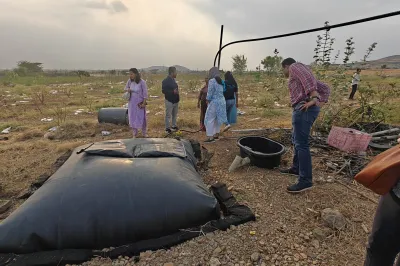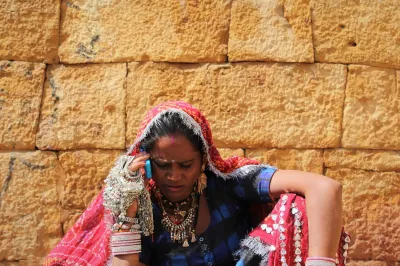Remembering PINs in Rural Bangladesh
Firsthand observations in some of the branchless banking initiatives around the world indicate that poor customers tend to struggle with remembering and correctly entering their personal identification number (PIN) to access and verify transactions in their branchless banking account.
 With the help of a microcredit loan, Amena Begum has created a livelihood for herself. She colors threads and sells them to the taant sari industry.
With the help of a microcredit loan, Amena Begum has created a livelihood for herself. She colors threads and sells them to the taant sari industry.
Specifically, we ran up against this challenge in a G2P payments pilot currently underway in Bangladesh. CGAP and the World Bank Social Protection Unit, in collaboration with pi Strategy Consulting, are working on a pilot to test an innovative technology-enabled payment system and attendance verification system for the Employment Generation Program for the Poorest (EGPP).
EGPP is a large workfare program that provides short-term employment during agricultural lean seasons to poor and vulnerable households. Beneficiaries receive weekly payments based on their work attendance. Irregularities in attendance records at the worksite and payments to ghost workers were some of the challenges faced in EGPP. A robust attendance system was therefore one aspect of the project that was first piloted in Belkuchi, Sirajgonj during March through April of 2012.
As a part of this process, the EGPP beneficiaries were assigned a PIN that they were expected to use to verify their attendance. However, during the pilot it was observed that many beneficiaries (all of whom are very poor with very limited education levels) found it quite difficult to remember their 4-digit numeric PINs and enter them into the POS keypad while verifying attendance.
In response, we carried out a week-long study to assess whether and how the beneficiaries can be trained to: (a) recognize the numbers since many are illiterate, and (b) remember the numbers.
The PIN experiment was designed mainly to evaluate the present competence, or lack thereof, of the beneficiaries for remembering a PIN whether it is in numeric form (English or Bengali) or a symbol. At the same time, we wanted to see if there was any noticeable improvement after providing 6 – 7 hours of training to them (over a period of four days).
The PIN experiment broadly had two parts: pattern recognition and memory association. To better define the target audience, beneficiaries were divided into three groups: A, B and C. Each group dealt with separate types of PIN namely - English, Bengali (native language) and Symbolic PIN.
During pattern recognition sessions, beneficiaries were guided to connect objects they are familiar with to numeric digits that have similar patterns/shapes. For example, a plough is a popular tool for land cultivation in Bangladesh and beneficiaries of EGPP are quite familiar with it. The plough, at least a portion of it, has similar pattern with digit ‘7’ (see figure 1). Therefore if the beneficiary can identify the pattern of a plough, she should easily identify ‘7’ if she is guided to connect these two things in her mind properly. Based on the above assumption, beneficiaries were guided to identify patterns of 0 to 9 both in English and Bengali.

To better assess their grasp of these patterns, a number of trials were conducted using Number Boards.
Number Boards are laminated sheets with 0 to 9 digits printed on them in either sequential or random order (see figure 2). Beneficiaries were asked to place Number Cards, which have one digit printed on each of them, on the right location of the Number Board. A variation of the Number Board was also used with engraved patterns instead of a flat surface for those that seemed challenged by the Number Board trials (see figure 3).

During the memory association exercise, beneficiaries were instructed to link numbers with things in their daily lives. For example, one of the beneficiaries said that he has two grandchildren. He was instructed to recall the digit ‘2’ by remembering the number of grandchildren he has. The major part of the memory association was conducted through sequential trials and tests where beneficiaries were asked to recall a number.

So what did we learn from these experiments? First, beneficiaries were found to be more familiar with English numeric digits than with Bengali digits. This suggests that although many do not own a personal mobile phone in the target group where mobile penetration rate is around 30%, most of the beneficiaries have gained a considerable level of familiarity with mobile phone keypads that feature English digits. Second, in memory association exercises with numeric digits, the concept of connecting the numbers with something personal did not seem to help beneficiaries remember their PIN. Instead, they memorized the entire numeric string without any explicit logic or link between the digits and were found comfortable doing so. Third, beneficiaries who were trained to use the symbols as PIN required less effort and performed significantly better than the groups with numeric PINs. Beneficiaries who were able to identify some of the patterns still found it confusing to distinguish between some sets of ‘look-a-like’ digits (1, 7 and 4; 6 and 9; 2 and 5).
The insights generated from the PIN experiment not only informed improvements in implementing the EGPP pilot but also gave us a good sense of the existing behavior of BOP segments on the usage of numbers in their daily life. Perhaps, there is a business case within G2P programs for investing in training / capacity development of the end users rather than investing in biometric authentication technologies. And if indeed such capacity development efforts can lead to better numeracy skills that contribute to improving livelihoods of the poor, we will have killed two birds with one stone.
The author is the Managing Partner of pi Strategy Consulting based in Dhaka.




Comments
Dear Mr. Islam:
Dear Mr. Islam:
There is indeed a business case for this. I wrote about it a few years ago related to the case of microsavings -- where both the cost of control systems, and the balances clients are prepared to hold, would both appear to depend significantly on client capabilities to follow and understand the records of the transactions taking place within their accounts.
In my view, client capabilities are a bottleneck holding back not just microsavings in the real world, but mobile and agency-based versions as well. The CGAP link to the paper "Orality and Microsavings" is dead, but you can access it on the publications page of our own website at http://myoralvillage.org/wordpress/about/publications/. The whole of this website takes a capabilities- and behavior-based approach to the market failures that still plague our efforts to achieve financial inclusion among illiterate and innumerate populations.
Feel free to contact me if you wish to learn more. brett@myoralvillage.org.
Add new comment